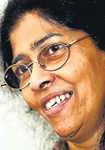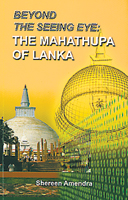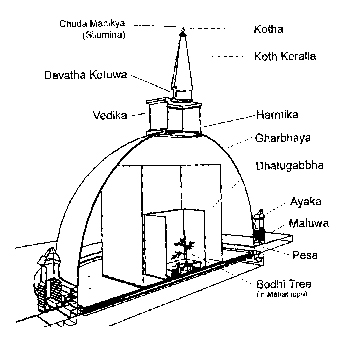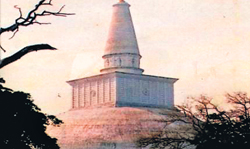The mystery of Mahathupa
An architect’s attempt to unearth secrets of Ruwanweliseya
Poring over the Mahavamsa, some aspects of the information in the Great Chronicle of Ceylon, intrigued and aroused the curiosity of architect Shereen Amendra.
 |
| Shereen Amendra. |
Whereas the establishment by ancient kings of many stupas across the island had been recorded with the basic information of where they were built and by whom, the Mahavamsa written in the 5th century singled out one for special detail.
The chronicle dealt with all aspects of this stupa - its shape, its size, its dimensions, the material used for its construction, the list was endless.
 |
Why, questioned Mrs. Amendra, coming up with the answer herself……. "because it was unique".
That was the beginning of her quest to delve deeper and deeper not only into the Mahavamsa but all books, literature, anything she could lay her hands on to discover what made this stupa unique.
And her journey of sifting, sorting, analysing and interpreting, with the added advantage of modern technology, has led her to a startling discovery, a discovery that most of us, not only the white-clad Buddhist men, women and children who sit in meditation or reverence around it feel, but all Sri Lankans who walk the hallowed precincts, may experience but may not be able to pinpoint what it is.
The pristine white 'Mahathupa' or Ruwanweliseya, enshrining the relics of Lord Buddha, dominates the skyline of Anuradhapura and is unique and special. For, postulates Mrs. Amendra, the ancients had a knowledge of mind-boggling technology - technology known to present generations only recently.
 |
| A cut-away view showing parts of a stupa |
"The architecture of the Mahathupa has a significant relationship to modern-day technology and is believed to have functions beyond that of a monument or honoured reliquary. It embodies electronics and electrical aspects. It is amazing," she says simply, in wonderment at how she seems to have been "directed" to pick up the messages not only in the Mahavamsa but also the Thupavamsa.
 |
| Ruwanweliseya: An architectural marvel |
In her book, 'Beyond the seeing eye: The Mahathupa of Lanka' launched just last week by the Sri Lanka Institute of Architects, Mrs. Amendra, 58, has attempted to put her discovery into a spiritual framework.
"The materials, functions and resultant form of this monument are of great national importance with international and indeed universal connotations," says Mrs. Amendra asking whether it is a first of its kind globally.
Conceding that she feels privileged to produce a work that is both scientific and spiritual, unassuming Mrs. Amendra says that as far as she knows there has been no official archaeological research up to date within the Ruwanweliseya. "This is a completely new outlook…. a new interpretation on an ancient record, which has lain hidden because the world neither understood nor realised the extent of knowledge of the ancients."
I was privileged to see it and interpret it, she smiles, adding that her younger son, Sajith, helped with three-dimensional graphics while her elder son Shantha and daughter-in-law Niloo chipped in with some of the photographs.
She went many times to Anuradhapura, met with the Ruwanweli Mahaseya's Chief Incumbent Ven. Pallegama Hemarathana Nayaka Sthavira and walked among the ruins, spoke to many people - some of whom told her that Ruwanweliseya langa amuththak thiyenawa (there's something special) — before her welcome labour, she considers one especially meant for her, ended.
Sacred relics are embodied in the stupa. We don't understand the great power generated thereof. Many are the legends in the Mahavamsa and one is that at the end of this kalpaya (an immense period of time in earth years), there would be a large gathering around the relics of the Buddha, with the Mahathupa acting as a message centre, she says, explaining that there is a record that King Bhathika who had much fervour had lain down by the Ruwanweliseya and heard preaching coming from the relic chamber.
"There may well be energy radiating from there, which links up with those meditating around the Mahathupa. This is the physical in the spiritual framework. There could also be a link with those in the region as well as those beyond this planet," says Mrs. Amendra, who recalls visiting the sacred sites in Anuradhapura, gently led by her father, the well-known Supreme Court Judge A.C. Alles, who is no more.
 |
For, Mrs. Amendra, who led a happy-go-lucky life as a child there was no burning desire to do architecture. She went to university and architecture was an avenue that opened up to her but gradually what happened by chance turned out to be a major interest.
Going down memory lane, she recalls how she read the book 'Restless Atom' a combination of physics and chemistry that interested her greatly. Later architecture opened up a huge world, a discipline that encompasses all areas -- arts, science, history, human endeavour.
Quoting a speaker at a previous Architects’ Forum who had said that "architecture stands between a pragmatic arts and a sensuous science", she adds that it also stands between practicality and spirituality, a combination of symbolic aspects, ambience and real building for people.
Her interest in the sciences came in handy in her research not only on the Mahathupa but also the "special" location of Sri Lanka.
Originally presented as a paper in 2006 at the National Conference on Architecture held by the SLIA she says the more she looked at that research, she felt there were some data gaps. "But," she laughs, "it was very unusual that I always got the information I needed without much trouble."
Little pointers indicated that she was meant to look beyond the brick and mortar and construction of the shape and form of the monumental marvel that is the 2,100-year-old Ruwanweliseya.
Looking for more information about the material used in the construction of the thupa's base, Mrs. Amendra goes on the internet, and out pops an article by a NASA researcher. A quick e-mail requesting permission to use some data elicits an immediate reply and two more articles from the same author.
Another time she receives an urgent call from her sister about a book she felt compelled to buy for her. It was a book on the architectural remains of Anuradhapura.
She herself goes to pay a licence fee and happens by a book exhibition, with the first book her hand goes to being one on lost civilizations, aspects of which and much more on themes such as earthquakes that Mrs. Amendra has included in her book.
Seated behind her desk piled high with books, newspaper clippings, there is a wistful note in her voice as she talks about husband Sunil, also an architect, who has gone on his journey beyond this world. "A gentleman to the fingertips his advice to me was, 'Never blame anyone else for anything. None of us are wholly blameless. Don't be judgmental'. I would have liked him to be here to see this work I have felt compelled to undertake."
Explaining that now she is at peace as she has set down her thoughts on paper and others could continue with non-invasive research, Mrs. Amendra stresses that her work is in no way meant to take away from the reverence and veneration to be accorded in homage to the Mahathupa.
"This knowledge may serve to further realize with more zeal and fervour that we should be humble in the face of forces we do not fully understand," she adds.
Why the Mahathupa is unique, as taken from Mrs. Amendra's book:* A dona of the Buddha's relics is enshrined within.
* The structure was ordained to be.
* The site was dedicated especially and consecrated many generations before by Arahant Mahinda.
* The particular site and location is special.
* The records are copious and detailed, unlike other stupas.
* The only stupa recorded to have a Bodhi tree embodied within.
* The particular use of many materials not found in other stupas, crystal, metals.
* The particular and deliberate design of the base layers.
* The particular and deliberate design of the relic chamber.
* The mention of the 'five-finger ornament'.
* The function of the crystal on the pinnacle as a beacon.
Here are a few quotations from the book to lure the reader:
"A modern-day (large) silicon chip if enlarged several thousands of times and consisting of not miniature circuitry, silicon wafer and pads, but vases, gold, iron network and mountain-crystal may have an uncanny resemblance to those base layers of the Mahathupa……
"Computers use the binary system for data storage and retrieval……….Thus 8, 16, 32, 64, 128, 256, 512, 1024….etc are numbers relating to data storage and retrieval. It is curious that the new vases numbering 1008, with the eight gold and eight silver vases add up to 1024. In computer jargon 1024 bytes add upto 1 kilobyte, or 1K. Was there any possibility for data storage built into the Mahathupa, possibly of 1K capacity?
"Given the grand design of the Mahathupa, it would be the first building in the world to embody electronics. Also the electronics within are meant to function in an integrated manner without further human intervention, thus qualifying the structure to be termed in today's parlance 'intelligent design' directed by the theras of the Mahavihara. Was this the first? What is 'first' for that which has no beginning or end? Do civilizations and technology arise and die out? At least on this planet, or perhaps within the universe?"

0 comments:
Post a Comment